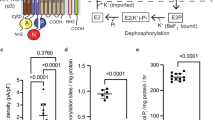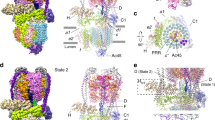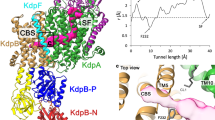Abstract
Na+,K+-ATPase pumps three Na+ ions out of cells in exchange for two K+ taken up from the extracellular medium per ATP molecule hydrolysed, thereby establishing Na+ and K+ gradients across the membrane in all animal cells. These ion gradients are used in many fundamental processes, notably excitation of nerve cells. Here we describe 2.8 Å-resolution crystal structures of this ATPase from pig kidney with bound Na+, ADP and aluminium fluoride, a stable phosphate analogue, with and without oligomycin that promotes Na+ occlusion. These crystal structures represent a transition state preceding the phosphorylated intermediate (E1P) in which three Na+ ions are occluded. Details of the Na+-binding sites show how this ATPase functions as a Na+-specific pump, rejecting K+ and Ca2+, even though its affinity for Na+ is low (millimolar dissociation constant). A mechanism for sequential, cooperative Na+ binding can now be formulated in atomic detail.
This is a preview of subscription content, access via your institution
Access options
Subscribe to this journal
Receive 51 print issues and online access
$199.00 per year
only $3.90 per issue
Buy this article
- Purchase on Springer Link
- Instant access to full article PDF
Prices may be subject to local taxes which are calculated during checkout




Similar content being viewed by others
References
Albers, R. W. Biochemical aspects of active transport. Annu. Rev. Biochem. 36, 727–756 (1967)
Post, R. L., Hegyvary, C. & Kume, S. Activation by adenosine triphosphate in the phosphorylation kinetics of sodium and potassium ion transport adenosine triphosphatase. J. Biol. Chem. 247, 6530–6540 (1972)
Apell, H. J. & Karlish, S. J. Functional properties of Na,K-ATPase, and their structural implications, as detected with biophysical techniques. J. Membr. Biol. 180, 1–9 (2001)
Morth, J. P. et al. Crystal structure of the sodium–potassium pump. Nature 450, 1043–1049 (2007)
Shinoda, T., Ogawa, H., Cornelius, F. & Toyoshima, C. Crystal structure of the sodium–potassium pump at 2.4 Å resolution. Nature 459, 446–450 (2009)
Ogawa, H., Shinoda, T., Cornelius, F. & Toyoshima, C. Crystal structure of the sodium-potassium pump (Na+,K+-ATPase) with bound potassium and ouabain. Proc. Natl Acad. Sci. USA 106, 13742–13747 (2009)
Laursen, M., Yatime, L., Nissen, P. & Fedosova, N. U. Crystal structure of the high-affinity Na+,K+-ATPase–ouabain complex with Mg2+ bound in the cation binding site. Proc. Natl Acad. Sci. USA 110, 10958–10963 (2013)
Toyoshima, C., Kanai, R. & Cornelius, F. First crystal structures of Na+,K+-ATPase: new light on the oldest ion pump. Structure 19, 1732–1738 (2011)
Morth, J. P. et al. A structural overview of the plasma membrane Na+,K+-ATPase and H+-ATPase ion pumps. Nature Rev. Mol. Cell Biol. 12, 60–70 (2011)
Toyoshima, C. & Mizutani, T. Crystal structure of the calcium pump with a bound ATP analogue. Nature 430, 529–535 (2004)
Sørensen, T. L., Møller, J. V. & Nissen, P. Phosphoryl transfer and calcium ion occlusion in the calcium pump. Science 304, 1672–1675 (2004)
Esmann, M. & Skou, J. C. Occlusion of Na+ by the Na,K-ATPase in the presence of oligomycin. Biochem. Biophys. Res. Commun. 127, 857–863 (1985)
Glynn, I. M. in The Enzymes of Biological Membranes Vol. 3 (ed. A. N. Martonosi ) 35–114 (1985). New York and London: Plenum
Abe, K., Tani, K., Nishizawa, T. & Fujiyoshi, Y. Inter-subunit interaction of gastric H+,K+-ATPase prevents reverse reaction of the transport cycle. EMBO J. 28, 1637–1643 (2009)
Jacobsen, M. D., Pedersen, P. A. & Jørgensen, P. L. Importance of Na,K-ATPase residue α1-Arg544 in the segment Arg544–Asp567 for high-affinity binding of ATP, ADP, or MgATP. Biochemistry 41, 1451–1456 (2002)
Nayal, M. & Di Cera, E. Valence screening of water in protein crystals reveals potential Na+ binding sites. J. Mol. Biol. 256, 228–234 (1996)
Pintschovius, J., Fendler, K. & Bamberg, E. Charge translocation by the Na+/K+-ATPase investigated on solid supported membranes: cytoplasmic cation binding and release. Biophys. J. 76, 827–836 (1999)
Toyoshima, C., Nakasako, M., Nomura, H. & Ogawa, H. Crystal structure of the calcium pump of sarcoplasmic reticulum at 2.6 Å resolution. Nature 405, 647–655 (2000)
Guàrdia, E., Rey, R. & Padró, J. A. Na+–Na+ and Cl−–Cl− ion pairs in water: mean force potentials by constrained molecular dynamics. J. Chem. Phys. 95, 2823–2831 (1991)
Vilsen, B. Mutant Glu781→Ala of the rat kidney Na+,K+-ATPase displays low cation affinity and catalyzes ATP hydrolysis at a high rate in the absence of potassium ions. Biochemistry 34, 1455–1463 (1995)
Vilsen, B., Ramlov, D. & Andersen, J. P. Functional consequences of mutations in the transmembrane core region for cation translocation and energy transduction in the Na+,K+-ATPase and the SR Ca2+-ATPase. Ann. NY Acad. Sci. 834, 297–309 (1997)
Pedersen, P. A., Nielsen, J. M., Rasmussen, J. H. & Jørgensen, P. L. Contribution to Tl+, K+, and Na+ binding of Asn776, Ser775, Thr774, Thr772, and Tyr771 in cytoplasmic part of fifth transmembrane segment in α-subunit of renal Na,K-ATPase. Biochemistry 37, 17818–17827 (1998)
Kuntzweiler, T. A., Arguello, J. M. & Lingrel, J. B. Asp804 and Asp808 in the transmembrane domain of the Na,K-ATPase α subunit are cation coordinating residues. J. Biol. Chem. 271, 29682–29687 (1996)
Imagawa, T., Yamamoto, T., Kaya, S., Sakaguchi, K. & Taniguchi, K. Thr-774 (transmembrane segment M5), Val-920 (M8), and Glu-954 (M9) are involved in Na+ transport, and Gln-923 (M8) is essential for Na,K-ATPase activity. J. Biol. Chem. 280, 18736–18744 (2005)
Einholm, A. P., Toustrup-Jensen, M. S., Holm, R., Andersen, J. P. & Vilsen, B. The rapid-onset dystonia parkinsonism mutation D923N of the Na+, K+-ATPase α3 isoform disrupts Na+ interaction at the third Na+ site. J. Biol. Chem. 285, 26245–26254 (2010)
Morth, J. P. et al. The structure of the Na+,K+-ATPase and mapping of isoform differences and disease-related mutations. Phil. Trans. R. Soc. B 364, 217–227 (2009)
Schack, V. R., Holm, R. & Vilsen, B. Inhibition of phosphorylation of Na+,K+-ATPase by mutations causing familial hemiplegic migraine. J. Biol. Chem. 287, 2191–2202 (2012)
Jewell-Motz, E. A. & Lingrel, J. B. Site-directed mutagenesis of the Na,K-ATPase: consequences of substitutions of negatively-charged amino acids localized in the transmembrane domains. Biochemistry 32, 13523–13530 (1993)
Vilsen, B. Glutamate 329 located in the fourth transmembrane segment of the α-subunit of the rat kidney Na+,K+-ATPase is not an essential residue for active transport of sodium and potassium ions. Biochemistry 32, 13340–13349 (1993)
Clarke, D. M., Loo, T. W., Inesi, G. & MacLennan, D. H. Location of high affinity Ca2+-binding sites within the predicted transmembrane domain of the sarcoplasmic reticulum Ca2+-ATPase. Nature 339, 476–478 (1989)
Toustrup-Jensen, M. S. et al. The C terminus of Na+,K+-ATPase controls Na+ affinity on both sides of the membrane through Arg935. J. Biol. Chem. 284, 18715–18725 (2009)
Yaragatupalli, S., Olivera, J. F., Gatto, C. & Artigas, P. Altered Na+ transport after an intracellular α-subunit deletion reveals strict external sequential release of Na+ from the Na/K pump. Proc. Natl Acad. Sci. USA 106, 15507–15512 (2009)
Meier, S., Tavraz, N. N., Durr, K. L. & Friedrich, T. Hyperpolarization-activated inward leakage currents caused by deletion or mutation of carboxy-terminal tyrosines of the Na+/K+-ATPase α subunit. J. Gen. Physiol. 135, 115–134 (2010)
Vedovato, N. & Gadsby, D. C. The two C-terminal tyrosines stabilize occluded Na/K pump conformations containing Na or K ions. J. Gen. Physiol. 136, 63–82 (2010)
Schulz, S. & Apell, H. J. Investigation of ion binding to the cytoplasmic binding sites of the Na,K-pump. Eur. Biophys. J. 23, 413–421 (1995)
Cornelius, F. & Skou, J. C. The sided action of Na+ on reconstituted shark Na+/K+-ATPase engaged in Na+–Na+ exchange accompanied by ATP hydrolysis. II. Transmembrane allosteric effects on Na+ affinity. Biochim. Biophys. Acta 944, 223–232 (1988)
Schneeberger, A. & Apell, H. J. Ion selectivity of the cytoplasmic binding sites of the Na,K-ATPase: II. Competition of various cations. J. Membr. Biol. 179, 263–273 (2001)
Toyoshima, C. et al. Crystal structures of the calcium pump and sarcolipin in the Mg2+-bound E1 state. Nature 495, 260–264 (2013)
Winther, A. M. et al. The sarcolipin-bound calcium pump stabilizes calcium sites exposed to the cytoplasm. Nature 495, 265–269 (2013)
Jørgensen, P. L. Purification and characterization of (Na+ + K+)-ATPase. 3. Purification from the outer medulla of mammalian kidney after selective removal of membrane components by sodium dodecylsulphate. Biochim. Biophys. Acta 356, 36–52 (1974)
Schack, V. R. et al. Identification and function of a cytoplasmic K+ site of the Na+, K+ -ATPase. J. Biol. Chem. 283, 27982–27990 (2008)
Otwinowski, Z. & Minor, W. Processing of X-ray diffraction data collected in oscillation mode. Methods Enzymol. 276, 307–325 (1997)
Brünger, A. T. et al. Crystallography & NMR system: a new software suite for macromolecular structure determination. Acta Crystallogr. D 54, 905–921 (1998)
Fabiola, F., Bertram, R., Korostelev, A. & Chapman, M. S. An improved hydrogen bond potential: impact on medium resolution protein structures. Protein Sci. 11, 1415–1423 (2002)
Adams, P. D. et al. PHENIX: a comprehensive Python-based system for macromolecular structure solution. Acta Crystallogr. D 66, 213–221 (2010)
Collaborative Computational Project, 4. The CCP4 suite: programs for protein crystallography. Acta Crystallogr. D 50, 760–763 (1994)
McDonald, I. K. & Thornton, J. M. Satisfying hydrogen bonding potential in proteins. J. Mol. Biol. 238, 777–793 (1994)
Hayward, S. Structural principles governing domain motions in proteins. Proteins 36, 425–435 (1999)
Brown, I. D. & Wu, K. K. Empirical parameters for calculating cation-oxygen bond valences. Acta Crystallogr. B 32, 1957–1959 (1976)
Kraulis, P. MOLSCRIPT: a program to produce both detailed and schematic plots of protein structures. J. Appl. Cryst. 24, 946–950 (1991)
Ho, B. K. & Gruswitz, F. HOLLOW: Generating accurate representations of channel and interior surfaces in molecular structures. BMC Struct. Biol. 8, 49 (2008)
Acknowledgements
We thank S. Hasegawa and H. Okumura of the Japan Synchrotron Radiation Research Institute (JASRI) for data collection at BL41XU of SPring-8, and J. Petersen, A. M. Beck Sørensen and A. Lillevang for technical assistance with membrane purification. We are grateful to D. B. McIntosh for help in improving the manuscript, and J. Tsueda for help in preparing figures. This work is a part of a long-term project (2009B0025) at SPring-8 and was supported by a Specially Promoted Project Grant from the Ministry of Education, Culture, Sports, Science and Technology of Japan (to C.T.) as well as by research grants from the Lundbeck Foundation (to B.V.), the Novo Nordisk Foundation, Fabrikant Vilhelm Pedersen og Hustrus Legat (to B.V. and F.C.), the Danish Medical Research Council (to B.V. and F.C.) and the FI/Danish-Japanese cooperation program from the Danish Agency for Science Technology and Innovation (to F.C.).
Author information
Authors and Affiliations
Contributions
C.T., B.V. and F.C. planned and supervised the study. B.V. and F.C. prepared purified membranes containing Na+,K+-ATPase. R.K. and C.T. crystallized the ATPase; R.K., H.O. and C.T. collected diffraction data, determined the structure and prepared figures. C.T., B.V. and F.C. wrote the paper. All authors discussed the results and commented on the manuscript.
Corresponding author
Ethics declarations
Competing interests
The authors declare no competing financial interests.
Supplementary information
Supplementary Information
This file contains a Supplementary Discussion, additional references, Supplementary Tables 1-2 and Supplementary Figures 1-19. (PDF 8354 kb)
Rights and permissions
About this article
Cite this article
Kanai, R., Ogawa, H., Vilsen, B. et al. Crystal structure of a Na+-bound Na+,K+-ATPase preceding the E1P state. Nature 502, 201–206 (2013). https://doi.org/10.1038/nature12578
Received:
Accepted:
Published:
Issue Date:
DOI: https://doi.org/10.1038/nature12578
This article is cited by
-
The effect of cytochrome c on Na,K-ATPase
Journal of Bioenergetics and Biomembranes (2024)
-
The Na+,K+-ATPase and its stoichiometric ratio: some thermodynamic speculations
Biophysical Reviews (2023)
-
Identification of the NA+/K+-ATPase α-Isoforms in Six Species of Poison Dart Frogs and their Sensitivity to Cardiotonic Steroids
Journal of Chemical Ecology (2023)
-
Electrostatic switch mechanisms of membrane protein trafficking and regulation
Biophysical Reviews (2023)
-
Structure and function of H+/K+ pump mutants reveal Na+/K+ pump mechanisms
Nature Communications (2022)
Comments
By submitting a comment you agree to abide by our Terms and Community Guidelines. If you find something abusive or that does not comply with our terms or guidelines please flag it as inappropriate.



